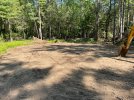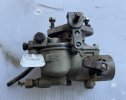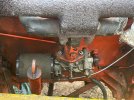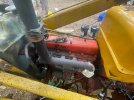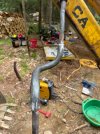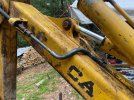That's really helpful, thanks!
So you are saying there is no suction tube inside the loader frame reservoir that goes further below the fitting on the frame that connects to the pump input?
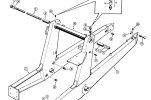
Also, there is only a 1/4" plug on the front right side frame by the radiator, not on the left, which doesn't make any sense to me. Is there always a giant air cavity on the front of the left side frame? The left side frame only has the two hydraulic line connections, the top 1/4" vent, and the bottom 3/4" drain plug that is actually a few inches up from the bottom creating a nearly impossible to clean area.
After the flush when I refilled, I put a 1/4 npt to 3/8 hose barb adapter in place of that plug and put a 5' length of clear hose clamped up to the muffler so I could see the air bleed out as I filled. When I filled a third time after rebuilding some cylinders, I realized could just back the plug out til I could hear the air hiss out, and then close when oil starts to flow. It's pretty messy trying to remove the hose barb and replace the plug I learned.

I've been refilling with traveller iso 46 oil, it's affordable and availabile at the red farmer walmart nearest to me. The oil in the system finally cleared up, between a blown hose, rebuilding cylinders, and all the little leaks, I've added almost 10 more gallons since the flush.
Questions about the shuttle...
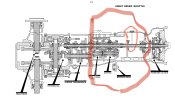
What is the level the oil should be in the shuttle reservoir? Manual shows a dipstick on the cap on the torque tube, but I just have a cap only. Also, this is just a fully mechanical gearbox right? Just the shuttle and the high/low range box. No clutches or torque converters. No hydraulics. Why can't I put any machine oil here? Right now its a reddish fluid, and the only oil on this machine that wasn't milky, even though the shuttle cover plate had no gasket and leaked all around, so I'm sure there's water in there. This is also the last reservoir on the machine that I haven't flushed, and based on the terrifying globs that came out of every other reservoir I know it's gonna be ugly...
My thinking is, this is a 55 year old machine that has clearly been through the ringer, and it's been neglected for years... Somehow it's still ripping out stumps and piling them up... I really don't have any reason to drive this around out here in the woods in anything other than low 1st or high 1st. The gears make a bit of noise in low. Why not just throw some 90w gear oil in there? I can't imagine using this in the winter up here in the mountains. How is this gearbox any different than the one right next to it with the 4 speed?



